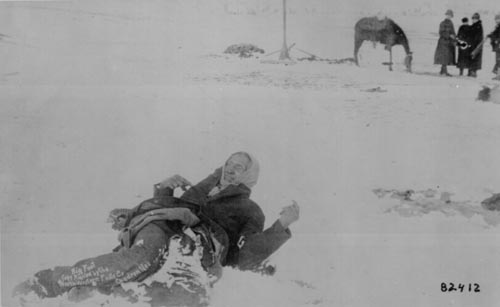|
|

Wounded Knee

"Return of Casey's scouts from the fight at Wounded Knee, 1890--91."
Soldiers on horseback plod through the snow.

"Big Foot, leader of the Sioux, captured at the battle of Wounded Knee, S.D."
Here he lies frozen on the snow-covered battlefield where he died, 1890.
White officials became alarmed at the religious fervor and activism and in December 1890 banned the Ghost Dance on Lakota reservations. When the rites continued, officials called in troops to Pine Ridge and Rosebud reservations in South Dakota. The military, led by veteran General Nelson Miles, geared itself for another campaign.
The presence of the troops exacerbated the situation. Short Bull and Kicking Bear led their followers to the northwest corner of the Pine Ridge reservation, to a sheltered escarpment known as the Stronghold. The dancers sent word to Sitting Bull of the Hunkpapas to join them. Before he could set out from the Standing Rock reservation in North Dakota, however, he was arrested by Indian police. A scuffle ensued in which Sitting Bull and seven of his warriors were slain. Six of the policemen were killed.
General Miles had also ordered the arrest of Big Foot, who had been known to live along the Cheyenne River in South Dakota. But, Big Foot and his followers had already departed south to Pine Ridge, asked there by Red Cloud and other supporters of the whites, in an effort to bring tranquility. Miles sent out the infamous Seventh Calvary led by Major Whitside to locate the renegades. They scoured the Badlands and finally found the Miniconjou dancers on Porcupine Creek, 30 miles east of Pine Ridge. The Indians offered no resistance. Big Foot, ill with pneumonia, rode in a wagon. The soldiers ordered the Indians to set up camp five miles westward, at Wounded Knee Creek. Colonel James Forsyth arrived to take command and ordered his guards to place four Hotchkiss cannons in position around the camp. The soldiers now numbered around 500; the Indians 350, all but 120 of these women and children.
The following morning, December 29, 1890, the soldiers entered the camp demanding the all Indian firearms be relinquished. A medicine man named Yellow Bird advocated resistance, claiming the Ghost Shirts would protect them. One of the soldiers tried to disarm a deaf Indian named Black Coyote. A scuffle ensued and the firearm discharged. The silence of the morning was broken and soon other guns echoed in the river bed. At first, the struggle was fought at close quarters, but when the Indians ran to take cover, the Hotchkiss artillery opened up on them, cutting down men, women, children alike, the sick Big Foot among them. By the end of this brutal, unnecessary violence, which lasted less than an hour, at least 150 Indians had been killed and 50 wounded. In comparison, army casualties were 25 killed and 39 wounded. Forsyth was later charged with killing the innocents, but exonerated.
|
|
|
|
|
 Native American Nations
Native American Nations
